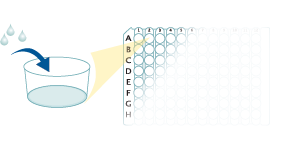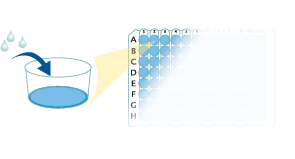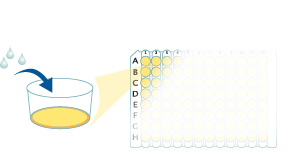Human CCL17/TARC Quantikine ELISA Kit Summary
Product Summary
Precision
Cell Culture Supernates
| Intra-Assay Precision | Inter-Assay Precision | |||||
|---|---|---|---|---|---|---|
| Sample | 1 | 2 | 3 | 1 | 2 | 3 |
| n | 20 | 20 | 20 | 40 | 40 | 40 |
| Mean (pg/mL) | 88 | 504 | 1001 | 89 | 540 | 1033 |
| Standard Deviation | 4.1 | 21.7 | 27.2 | 8.3 | 38.9 | 71.7 |
| CV% | 4.7 | 4.3 | 2.7 | 9.3 | 7.2 | 6.9 |
Serum, EDTA Plasma, Heparin Plasma
| Intra-Assay Precision | Inter-Assay Precision | |||||
|---|---|---|---|---|---|---|
| Sample | 1 | 2 | 3 | 1 | 2 | 3 |
| n | 20 | 20 | 20 | 40 | 40 | 40 |
| Mean (pg/mL) | 87 | 600 | 1107 | 98 | 616 | 1178 |
| Standard Deviation | 6.2 | 13.7 | 29.9 | 8.9 | 50.7 | 88.8 |
| CV% | 7.1 | 2.3 | 2.7 | 9.1 | 8.2 | 7.5 |
Recovery
The recovery of TARC spiked to three different levels throughout the range of the assay in various matrices was evaluated.
| Sample Type | Average % Recovery | Range % |
|---|---|---|
| Cell Culture Media (n=4) | 95 | 88-104 |
| EDTA Plasma (n=5) | 102 | 86-111 |
| Heparin Plasma (n=5) | 98 | 86-107 |
| Serum (n=5) | 105 | 100-114 |
Linearity
Scientific Data
Product Datasheets
Preparation and Storage
Background: Luminex 200 Instrument
CCL17/TARC is a chemokine that interacts with CCR4 and CCR8 to induce the chemoattraction of activated Th2 cells, basophils, and NK cells. It is produced by thymic dendritic cells, lymph node dendritic cells, monocytes, CD4+ T cells, keratinocytes, fibroblasts, bronchial epithelial cells, and Reed-Sternberg cells. CCL17 promotes Th2 cell recruitment to sites of inflammation and induces platelet aggregation and degranulation.
Assay Procedure
Refer to the product- Prepare all reagents, standard dilutions, and samples as directed in the product insert.
- Remove excess microplate strips from the plate frame, return them to the foil pouch containing the desiccant pack, and reseal.
- Add 100 µL of Assay Diluent to each well.
- Add 50 µL of Standard, control, or sample to each well. Cover with a plate sealer, and incubate at room temperature for 2 hours.
- Aspirate each well and wash, repeating the process twice for a total of 3 washes.
- Add 200 µL of Conjugate to each well. Cover with a new plate sealer, and incubate at room temperature for 1 hour.
- Aspirate and wash 3 times.
- Add 200 µL Substrate Solution to each well. Incubate at room temperature for 30 minutes. PROTECT FROM LIGHT.
- Add 50 µL of Stop Solution to each well. Read at 450 nm within 30 minutes. Set wavelength correction to 540 nm or 570 nm.





Citations for Human CCL17/TARC Quantikine ELISA Kit
R&D Systems personnel manually curate a database that contains references using R&D Systems products. The data collected includes not only links to publications in PubMed, but also provides information about sample types, species, and experimental conditions.
41
Citations: Showing 1 - 10
Filter your results:
Filter by:
-
Matrine regulates Th1/Th2 inflammatory responses by inhibiting the Hsp90/NF-kappaB signaling axis to alleviate atopic dermatitis
Authors: P Huang, F Hu, ZB Yang, Y Pan, R Zhou, YN Yan, HZ Wang, C Wang
The Kaohsiung journal of medical sciences, 2023-02-09;0(0):.
Species: Mouse
Sample Types: Serum
-
Onchocerca volvulus-specific antibody and cellular responses in onchocerciasis patients treated annually with ivermectin for 30 years and exposed to parasite transmission in central Togo
Authors: SI Johanns, RG Gantin, B Wangala, K Komlan, WA Halatoko, M Banla, P Karabou, AJ Luty, H Schulz-Key, C Köhler, PT Soboslay
PloS Neglected Tropical Diseases, 2022-05-03;16(5):e0010340.
Species: Human
Sample Types: Cell Culture Supernates
-
EBV+ tumors exploit tumor cell-intrinsic and -extrinsic mechanisms to produce regulatory T cell-recruiting chemokines CCL17 and CCL22
Authors: A Jorapur, LA Marshall, S Jacobson, M Xu, S Marubayash, M Zibinsky, DX Hu, O Robles, JJ Jackson, V Baloche, P Busson, D Wustrow, DG Brockstedt, O Talay, PD Kassner, G Cutler
PloS Pathogens, 2022-01-13;18(1):e1010200.
Species: Human
Sample Types: Cell Culture Supernates
-
Circulating cytokines present in multiple myeloma patients inhibit the osteoblastic differentiation of adipose stem cells
Authors: L Kobari, M Auclair, O Piau, N Ferrand, M Zaoui, F Delhommeau, B Fève, M Sabbah, L Garderet
Leukemia, 2021-09-23;0(0):.
Species: Human
Sample Types: Plasma
-
M1-like macrophages are potent producers of anti-viral interferons and M1-associated marker-positive lung macrophages are decreased during rhinovirus-induced asthma exacerbations
Authors: A Nikonova, M Khaitov, DJ Jackson, S Traub, MB Trujillo-T, DA Kudlay, AS Dvornikov, A Del-Rosari, R Valenta, LA Stanciu, R Khaitov, SL Johnston
EBioMedicine, 2020-04-09;54(0):102734.
Species: Human
Sample Types: Cell Culture Supernates
-
miR-1291 Functions as a Potential Serum Biomarker for Bullous Pemphigoid
Authors: L Qiu, L Zhang, R Qi, X Gao, H Chen, T Xiao
Dis. Markers, 2020-01-11;2020(0):9505312.
Species: Human
Sample Types: Serum
-
Proteomic profiling of extracellular vesicles reveals additional diagnostic biomarkers for myocardial infarction compared to plasma alone
Authors: O Gidlöf, M Evander, M Rezeli, G Marko-Varg, T Laurell, D Erlinge
Sci Rep, 2019-06-20;9(1):8991.
Species: Human
Sample Types: Plasma
-
Mitochondrial fission-induced mtDNA stress promotes tumor-associated macrophage infiltration and HCC progression
Authors: D Bao, J Zhao, X Zhou, Q Yang, Y Chen, J Zhu, P Yuan, J Yang, T Qin, S Wan, J Xing
Oncogene, 2019-03-20;0(0):.
Species: Human
Sample Types: Cell Culture Supernates
-
Changes in the Anti-Allergic Activities of Sesame by Bioconversion
Authors: TD Jung, SI Choi, SH Choi, BY Cho, WS Sim, SJ Lee, SJ Park, DB Kim, YC Kim, JH Lee, OH Lee
Nutrients, 2018-02-14;10(2):.
Species: Human
Sample Types: Cell Culture Supernates
-
Skin Barrier Recovery by Protease-Activated Receptor-2 Antagonist Lobaric Acid
Authors: Jae Sung Hwang
Biomol Ther (Seoul), 2016-09-01;24(5):529-35.
Species: Human
Sample Types: Cell Culture Supernates
-
Expansion of activated regulatory T cells by myeloid-specific chemokines via an alternative pathway in CSF of bacterial meningitis patients.
Authors: Shi G, Han J, Liu G, Hao Y, Ma Y, Li T, Wu X, Zhang H, Liu Y, Wang B, Kong Y, Zhou J, Zeng H
Eur J Immunol, 2013-12-02;44(2):420-30.
Species: Human
Sample Types: Cell Culture Supernates
-
Prognostic significance of pretreatment serum cytokines in classical Hodgkin lymphoma.
Authors: Marri P, Hodge L, Maurer M, Ziesmer S, Slager S, Habermann T, Link B, Cerhan J, Novak A, Ansell S
Clin Cancer Res, 2013-10-18;19(24):6812-9.
Species: Human
Sample Types: Serum
-
BAFF/APRIL system in pediatric OMS: relation to severity, neuroinflammation, and immunotherapy.
Authors: Pranzatelli, Michael, Tate, Elizabet, McGee, Nathan R, Travelstead, Anna L, Colliver, Jerry A, Ness, Jayne M, Ransohoff, Richard
J Neuroinflammation, 2013-01-16;10(0):10.
Species: Human
Sample Types: Serum
-
Regulatory T cells suppress T cell activation at the pathologic site of human visceral leishmaniasis.
Authors: Rai AK, Thakur CP, Singh A
PLoS ONE, 2012-02-08;7(2):e31551.
Species: Human
Sample Types: Serum
-
Brentuximab vedotin (SGN-35) for relapsed CD30-positive lymphomas.
Authors: Younes A, Bartlett NL, Leonard JP
N. Engl. J. Med., 2010-11-04;363(19):1812-21.
Species: Human
Sample Types: Serum
-
Mepolizumab as a corticosteroid-sparing agent in lymphocytic variant hypereosinophilic syndrome.
Authors: Roufosse F, de Lavareille A, Schandene L, Cogan E, Georgelas A, Wagner L, Xi L, Raffeld M, Goldman M, Gleich GJ, Klion A
J. Allergy Clin. Immunol., 2010-10-01;126(4):828-835.
Species: Human
Sample Types: Serum
-
Distinct roles for CCR4 and CXCR3 in the recruitment and positioning of regulatory T cells in the inflamed human liver.
Authors: Oo YH, Weston CJ, Lalor PF, Curbishley SM, Withers DR, Reynolds GM, Shetty S, Harki J, Shaw JC, Eksteen B, Hubscher SG, Walker LS, Adams DH
J. Immunol., 2010-02-17;184(6):2886-98.
Species: Human
Sample Types: Cell Culture Supernates
-
The imbalance in serum concentration of Th-1- and Th-2-derived chemokines as one of the factors involved in pathogenesis of atopic dermatitis.
Authors: Narbutt J, Lesiak A, Sysa-Jedrzeiowska A, Zakrzewski M, Bogaczewicz J, Stelmach I, Kuna P
Mediators Inflamm., 2009-07-22;2009(0):269541.
Species: Human
Sample Types: Serum
-
Phenotype of atopic dermatitis subjects with a history of eczema herpeticum.
Authors: Beck LA, Boguniewicz M, Hata T, Schneider LC, Hanifin J, Gallo R, Paller AS, Lieff S, Reese J, Zaccaro D, Milgrom H, Barnes KC, Leung DY
J. Allergy Clin. Immunol., 2009-06-27;124(2):260-9, 269.e1.
Species: Human
Sample Types: Serum
-
Increases in serum TARC/CCL17 levels are associated with progression-free survival in advanced melanoma patients in response to dendritic cell-based immunotherapy.
Authors: Cornforth AN, Lee GJ, Fowler AW, Carbonell DJ, Dillman RO
J. Clin. Immunol., 2009-05-07;29(5):657-64.
Species: Human
Sample Types: Serum
-
In vitro induction of a dendritic cell phenotype in primary human acute myelogenous leukemia (AML) blasts alters the chemokine release profile and increases the levels of T cell chemotactic CCL17 and CCL22.
Authors: Olsnes AM, Ryningen A, Ersvaer E, Bruserud Ø
J. Interferon Cytokine Res., 2008-05-01;28(5):297-310.
Species: Human
Sample Types: Cell Culture Supernates
-
Development of an in vitro potency bioassay for therapeutic IL-13 antagonists: the A-549 cell bioassay.
Authors: Miller R, Sadhukhan R, Wu C
J. Immunol. Methods, 2008-03-07;334(1):134-41.
Species: Human
Sample Types: Cell Culture Supernates
-
Proteomics analysis of Hodgkin lymphoma: identification of new players involved in the cross-talk between HRS cells and infiltrating lymphocytes.
Authors: Ma Y, Visser L, Roelofsen H, de Vries M, Diepstra A, van Imhoff G, van der Wal T, Luinge M, Alvarez-Llamas G, Vos H, Poppema S, Vonk R, Van Den Berg A
Blood, 2007-12-10;111(4):2339-46.
Species: Human
Sample Types: Cell Culture Supernates
-
Specific recruitment of regulatory T cells into the CSF in lymphomatous and carcinomatous meningitis.
Authors: Haas J, Schopp L, Storch-Hagenlocher B, Fritzsching B, Jacobi C, Milkova L, Fritz B, Schwarz A, Suri-Payer E, Hensel M, Wildemann B
Blood, 2007-10-29;111(2):761-6.
Species: Human
Sample Types: CSF
-
Functional diversity of T-cell subpopulations in subacute and chronic hypersensitivity pneumonitis.
Authors: Barrera L, Mendoza F, Zuniga J, Estrada A, Zamora AC, Melendro EI, Ramirez R, Pardo A, Selman M
Am. J. Respir. Crit. Care Med., 2007-10-18;177(1):44-55.
Species: Human
Sample Types: BALF
-
Comparison of serum markers for allergic bronchopulmonary aspergillosis in cystic fibrosis.
Authors: Latzin P, Hartl D, Regamey N, Frey U, Schoeni MH, Casaulta C
Eur. Respir. J., 2007-09-26;31(1):36-42.
Species: Human
Sample Types: Serum
-
Circulating thymus- and activation-regulated chemokine/CCL17 is a useful biomarker for discriminating acute eosinophilic pneumonia from other causes of acute lung injury.
Authors: Miyazaki E, Nureki S, Ono E, Ando M, Matsuno O, Fukami T, Ueno T, Kumamoto T
Chest, 2007-06-01;131(6):1726-34.
Species: Human
Sample Types: BALF
-
Der p, IL-4, and TGF-beta cooperatively induce EGFR-dependent TARC expression in airway epithelium.
Authors: Heijink IH, Marcel Kies P, van Oosterhout AJ, Postma DS, Kauffman HF, Vellenga E
Am. J. Respir. Cell Mol. Biol., 2006-10-05;36(3):351-9.
Species: Human
Sample Types: Cell Culture Supernates
-
CD16+ monocyte-derived macrophages activate resting T cells for HIV infection by producing CCR3 and CCR4 ligands.
Authors: Ancuta P, Autissier P, Wurcel A, Zaman T, Stone D, Gabuzda D
J. Immunol., 2006-05-15;176(10):5760-71.
Species: Human
Sample Types: Cell Culture Supernates
-
Chemokines indicate allergic bronchopulmonary aspergillosis in patients with cystic fibrosis.
Authors: Hartl D, Latzin P, Zissel G, Krane M, Krauss-Etschmann S, Griese M
Am. J. Respir. Crit. Care Med., 2006-03-16;173(12):1370-6.
Species: Human
Sample Types: Serum
-
Glucocorticoid-induced tumour necrosis factor receptor (GITR) and its ligand (GITRL) in atopic dermatitis.
Authors: Baumgartner-Nielsen J, Vestergaard C, Thestrup-Pedersen K
Acta Derm. Venereol., 2006-01-01;86(5):393-8.
Species: Human
Sample Types: Plasma
-
Serum levels of cutaneous T-cell attracting chemokine (CTACK) as a laboratory marker of the severity of atopic dermatitis in children.
Authors: Hon KL, Leung TF, Ma KC, Li AM, Wong Y, Fok TF
Clin. Exp. Dermatol., 2004-05-01;29(3):293-6.
Species: Human
Sample Types: Serum
-
Increased macrophage-derived chemokine in exhaled breath condensate and plasma from children with asthma.
Authors: Leung TF, Wong GW, Ko FW, Lam CW, Fok TF
Clin. Exp. Allergy, 2004-05-01;34(5):786-91.
Species: Human
Sample Types: Plasma
-
CSF chemokine levels in relapsing neuromyelitis optica and multiple sclerosis.
Authors: Narikawa K, Misu T, Fujihara K, Nakashima I, Sato S, Itoyama Y
J. Neuroimmunol., 2004-04-01;149(1):182-6.
Species: Human
Sample Types: Serum
-
Helper T-lymphocyte-related chemokines in healthy newborns.
Authors: Leung TF, Ng PC, Tam WH, Li CY, Wong E, Ma TP, Lam CW, Fok TF
Pediatr. Res., 2003-11-19;55(2):334-8.
Species: Human
Sample Types: Serum
-
Thymus and activation-regulated chemokine (TARC/CCL17) produced by mouse epidermal Langerhans cells is upregulated by TNF-alpha and IL-4 and downregulated by IFN-gamma.
Authors: Xiao T, Fujita H, Saeki H, Mitsui H, Sugaya M, Tada Y, Kakinuma T, Torii H, Nakamura K, Asahina A, Tamaki K
Cytokine, 2003-08-01;23(4):126-32.
Species: Human
Sample Types: Serum
-
Elevated levels of thymus and activation-regulated chemokine (TARC) in pleural effusion samples from patients infested with Paragonimus westermani.
Authors: Matsumoto N, Mukae H, Nakamura-Uchiyama F, Ashitani JI, Abe K, Katoh S, Kohno S, Nawa Y, Matsukura S
Clin. Exp. Immunol., 2002-11-01;130(2):314-8.
Species: Human
Sample Types: Pleural Effusion
-
Characterization of monocyte subtypes in the allergic form of atopic eczema/dermatitis syndrome.
Authors: Novak N, Allam P, Geiger E, Bieber T
Allergy, 2002-10-01;57(10):931-5.
Species: Human
Sample Types: Serum
-
Skewing of cytotoxic activity and chemokine production, but not of chemokine receptor expression, in human type-1/-2 gamma delta T lymphocytes.
Authors: D'Ambrosio D
Eur. J. Immunol., 2002-10-01;32(10):2934-43.
Species: Human
Sample Types: Cell Culture Supernates
-
A cytokine-to-chemokine axis between T lymphocytes and keratinocytes can favor Th1 cell accumulation in chronic inflammatory skin diseases.
Authors: Albanesi C, Scarponi C, Sebastiani S, Cavani A, Federici M, Sozzani S, Girolomoni G
J. Leukoc. Biol., 2001-10-01;70(4):617-23.
Species: Human
Sample Types: Cell Culture Supernates
-
Clonal Th2 cells associated with chronic hypereosinophilia: TARC-induced CCR4 down-regulation in vivo.
Authors: de Lavareille A, Roufosse F, Schandene L, Stordeur P, Cogan E, Goldman M
Eur. J. Immunol., 2001-04-01;31(4):1037-46.
Species: Human
Sample Types: Serum
FAQs
No product specific FAQs exist for this product, however you may
View all ELISA FAQsReviews for Human CCL17/TARC Quantikine ELISA Kit
Average Rating: 5 (Based on 1 Review)
Have you used Human CCL17/TARC Quantikine ELISA Kit?
Submit a review and receive an Amazon gift card.
$25/€18/£15/$25CAN/¥75 Yuan/¥2500 Yen for a review with an image
$10/€7/£6/$10 CAD/¥70 Yuan/¥1110 Yen for a review without an image
Filter by:
Importance of serum „Thymus and Activation-Regulated Chemokine (TARC) determination in classical Hodgkin lymphoma’s (cHL) patients
Thymus and Activation-Regulated Chemokine (TARC or CCL17) is highly expressed by Hodgkin and Reed-Sternberg cells and secreted into the serum. Therefore it can be a useful tumor marker of classical Hodgkin lymphoma (cHL). Our aim has been to study the value of serum TARC concentrations in the course of treatment, and follow up in patients with cHL. We enrolled 613 patients diagnosed with cHL, who were treated by the National Institute of Oncology, Hungary, between 2011 and 2018. Serum TARC levels were determined with a quantitative sandwich enzyme immunoassay technique (RnD Systems, Biotechne, Minneapolis, MN). Measurements were carried out in 3 month intervals following diagnosis, and 6 month intervals after 3 years. In 241 cases, serum TARC concentrations were determined before therapy, as well. Total number of measurements taken were 2015. Receiver Operating Characteristic (ROC) curve analysis was performed for comparison of healthy controls (n=168) and patients with active disease status before treatment (n=241). The cut-off value was 637 pg/ml with 90.9% sensitivity and 98.2% specificity. During follow-ups the median serum TARC value was 14350 pg/ml in patients with active disease status. In case of complete remission it was 401 pg/ml. ROC curve analysis of active versus complete remission groups showed a high 85.6% sensitivity and 93.7% specificity with a 936 pg/ml cut-off value. Our data confirmed the usefulness of TARC determination in the course of treatment and follow-up. TARC may be a potential marker for early response assessment and may be able to predict potential relapse of the disease. Determination of serum TARC concentrations with high sensitivity and cost-efficacy, is highly recommened for monitoring and at diagnosis of cHL patients.





